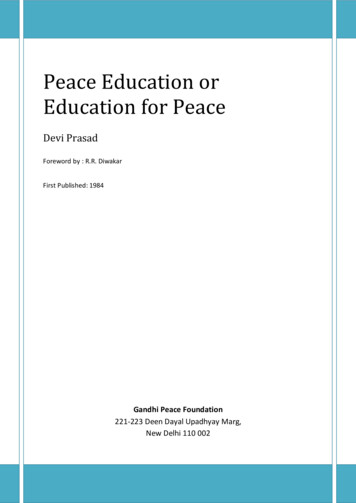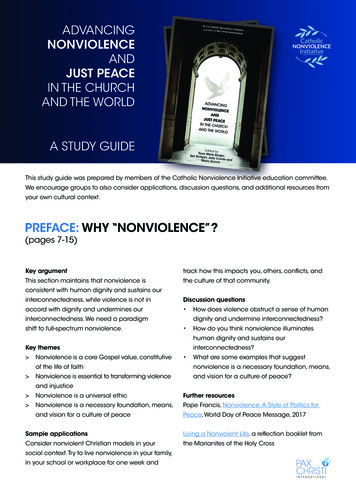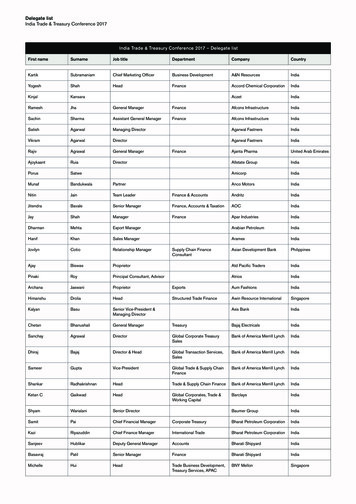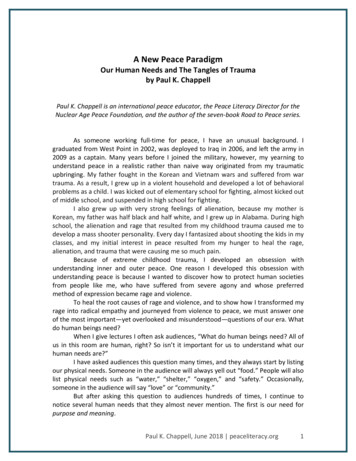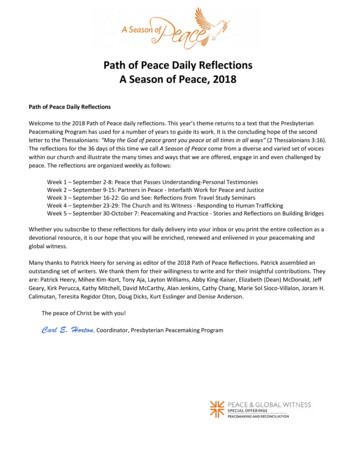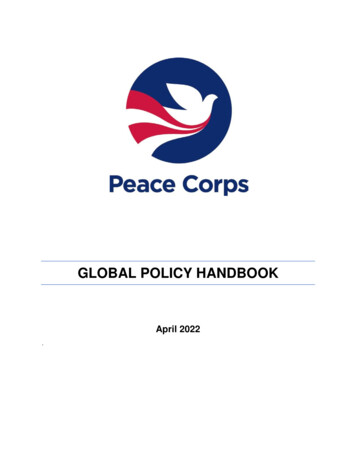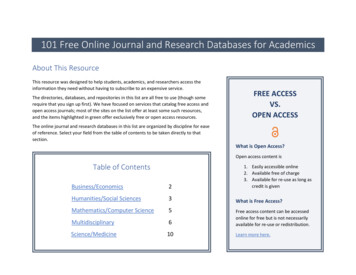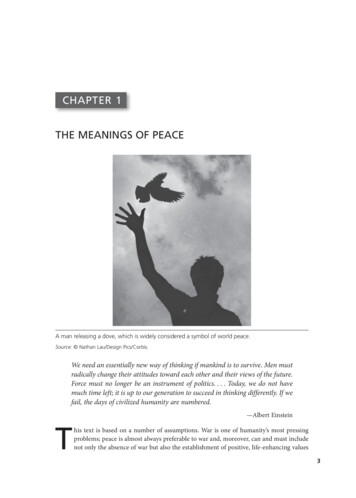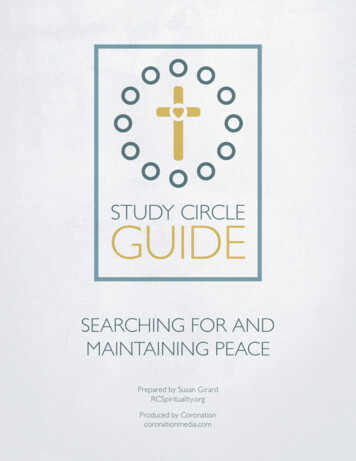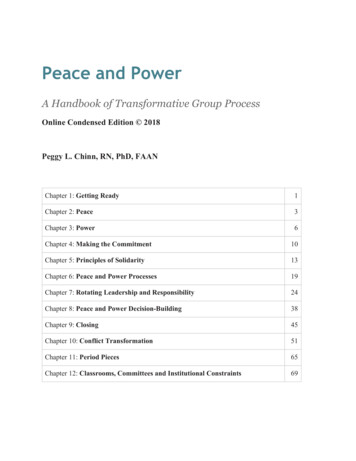
Transcription
Peace Education in India: Academics, Politics, and PeaceBarbara S. Tint and G. Koteswara PrasadThis article examines the evolution of peace education and peace studiesin India. Factors that influence the viability of this development includethe philosophical underpinnings of peace education, ideological issuesconcerning the relationship between academia and politics, and thestructural and economic conditions in India. An examination of Gandhi’slegacy provides an additional lens by which to understand the ways inwhich peace education has and has not been developed in India. The articlethen analyzes the launch of a Peace and Conflict Resolution Centre atthe University of Madras as a microcosm of these larger issues affectingpeace education in a global context. It concludes with recommendationsto enhance the success and visibility of this work and to support peaceeducation in India.In April of 2003, several academics from the University of Madras joined togetherto form a new interdisciplinary centre, the Centre for Peace and Conflict ResolutionStudies. Through the generous support of the International Council for EducationalExchange (ICEE) and the United States Educational Foundation in India (USEFI),a visiting Fulbright scholar went to Chennai in 2003/2004 to assist in the development of the Centre, to collaborate with its faculty members, and to offer variousprograms under its jurisdiction. During this time, the co-authors of this article,Dr. G. K. Prasad, the director of the Centre, and Dr. Barbara Tint, the Fulbrightscholar, had numerous conversations regarding the evolution, goals, mission, andresponsibilities of a centre such as this. Through these conversations, a variety ofissues and insights emerged that are relevant to our roles as peace researchers andeducators. The purpose of this article is to share some of these insights, to exploresome of the theoretical issues underlying the development of a Peace EducationCentre, to consider the development of this Centre as a microcosm of larger issuesaffecting peace educators in India, and to examine the role of academics in the workof peace within the Indian context. This exploration ends with some recommendations for advancing the work of peace education in this region.PEACE RESEARCHThe Canadian Journal of Peace and Conflict StudiesVolume 39, Numbers 1–2 (2007): 23-37 2007 Peace Research
24PEACE RESEARCH Vol. 39, Nos. 1-2 (2007)Peace EducationAs an academic discipline, peace education begs some clear definition; the evolving concept means different things in different contexts. Ian Harris suggests thatpeace education includes any attempt to teach about violence and alternatives toviolence.1 While this might present a useful starting point, we need a more focusedidea of what comprises this expanding discourse. Betty Reardon, one of the USA’sgroundbreaking peace educators, suggests that peace education is. . . [the] transmission of knowledge about the requirements of, theobstacles to and possibilities for achieving and maintaining peace,training in skills for interpreting the knowledge, and the developmentof reflective and participatory capacities for applying the knowledge toovercoming problems and achieving possibilities.2Peace education—education on peace-related content—is often distinguished fromeducation for peace, which is a holistic approach to education that seeks to shapeindividuals and societies.3 These two processes, however, are not mutually exclusive.As peace educators, we typically see our role as twofold: to educate students aboutissues related to peace, conflict, and violence, and to transmit ideas and values thatcan infuse our students with ways of engaging in the world that add to its potentialfor peace. Some suggest that the main goal of peace education is to influence peopleto behave more peacefully,4 or to develop caring and non-aggressive people whorelate peacefully to others in their own lives, facilitate the well-being of others, andwork to promote peace and prevent violence in society and the world at large.5 Thegoal is not regarded as simply to educate students but to transform societies: “Forpeace education to be effective, it must transform ways of thinking that have beendeveloped over the millennia of human history.”6 An emerging question for peaceeducators is the degree to which our work should be focused on content, comparedto the degree to which it should be focused on process, practice, and values that impact, both directly and indirectly, the students and contexts we encounter. A furtherquestion is to what degree academics take on the role of transforming societies assuggested above.Various dimensions of this field—conflict management, conflict resolution,conflict transformation, nonviolence studies, peace studies, peace research, andpeace science—have all been carved out as particular pieces of this pie, perhapsunnecessarily creating arbitrary divisions. In some contexts, what might be considered peace education is also known as education for democracy, civic education,tolerance education, or human rights education.7 Within its scope, peace education
Peace Education in India: Academics, Politics, and Peace25has included a focus on interpersonal, intra-group, inter-group, and internationalconflict. Within certain realms, inner peace, or a spiritual dimension, has beenrelated to the ability to impact larger global issues. Some contexts focus largely oninternational issues, while others prioritize the domestic domain.Harris has delineated five types of peace education, and attempts to providesome framework for these differing pieces of the pie: 1) Global Peace Education,which includes international studies, holocaust studies, and nuclear and disarmament studies; 2) Conflict Resolution Programs, which teach about mediation,negotiation, and various communication skills; 3) Violence Prevention Programs,which emphasize domestic violence, drug abuse, anger management, and theteaching of tolerance; 4) Development Education, which includes human rightseducation, environmental studies, and an emphasis on power, resource inequities,and structural violence; and 5) Nonviolence Education, which finds roots in theteachings and philosophies of Martin Luther King, Mahatma Gandhi, and othergreat peacemakers.8While most programs of peace education likely combine various componentsof the above categorizations, these constructs are useful to consider as we beginto analyze the contexts in which they are offered. While some elements of peaceeducation could be universal in relevance and applicability, Gavriel Salomon suggests that the ways we consider peace education should depend on the context inwhich it originates.9 The goals, methods, and opportunities of this discipline arelargely informed by the political climate of the region involved. Societies embeddedin deep violent conflict, those struggling with subtle ethnic tensions, and othersenjoying a climate of relative tranquility will each require a different integrationof this discipline in academic and political arenas. In considering these goals alongwith the components of peace education suggested by Harris, we can see the myriadways that peace education will vary according to context.However it is defined, peace education is a discipline that has gained muchmomentum in the last several decades. As a form of diplomatic intervention, it hascome to be accepted as essential to the social change necessary for peacemaking andpeacebuilding efforts worldwide. Education has long been considered an importantdimension of multi-track diplomacy in an ever-conflicted world.10 There has been atremendous increase in the number and types of certificate and degree programs offered in response to conflict and violence. The Global Directory of Peace Studies andConflict Resolution Programs profiles over 450 undergraduate, master's, and doctoralprograms and concentrations in over forty countries and thirty-eight Americanstates.11 The reasons why educational institutions develop peace education programs
26PEACE RESEARCH Vol. 39, Nos. 1-2 (2007)during these troubled times may seem obvious. However, how and why such coursesand curricula have been developed in some parts of the world and not in others maybe less obvious. Issues related to ideology, socioeconomic and structural conditions,and traditions of learning all play a part.Peace Education in IndiaWhile the development of peace studies curricula is becoming a global phenomenon,some regions of the world, including India, have only recently joined this academicdiscourse. Only in the last few years has higher education in India turned deliberate attention to peace studies. At a Conference on Conflict Resolution at the BirlaInstitute of Technology and Science, Jane Schukoske and Manjrika Sewak, citinginformation provided in 2003 by researcher Veena Bhalla at the Association ofIndian Universities, reported that there were no institutions in India offering conflict resolution courses, and only a few courses in negotiation or alternative disputeresolution.12 The Global Directory of Peace Studies and Conflict Resolution Programslists only three offerings in all of India: a postgraduate diploma in Human Rightsat the University of Hyderabad, “coursework” in peace studies at the University ofCalcutta, and a focus on Gandhian philosophy and theories of nonviolence at theCentre for Gandhian Studies.13Although peace education as a distinct academic discipline has been slow toemerge, Indian institutions of higher education have, in certain ways, addressedthe types of peace education that Harris delineates. These areas of focus are oftenscattered among various academic departments and suffer from a lack of coherentcurricula focused on issues of peace and conflict. Departments of political science,international studies, and defence and strategic studies exist in many departmentsand research centres within Indian universities and colleges. The defence collegesstudy issues around both nuclear and conventional weapons. Many of the thinktanks that discuss security issues in India are staffed with former military officerswho sometimes also deliberate non-traditional security. The topics of peace, nucleardisarmament, and international conflict tend to be studied with strong emphasis onpolitical, military, and strategic dimensions, and less on the intersection betweeninterpersonal, inter-group, and international phenomena. The students in thesearenas typically come from a relatively homogenous academic framework rather thanfrom an inter-disciplinary focus typical of other peace studies and conflict resolutionprograms. Since the Supreme Court of India’s 1991 directive around environmentalissues,14 environmental education has been taken more seriously, and since 2003 has
Peace Education in India: Academics, Politics, and Peace27become part of the compulsory education curriculum at all levels. Gender studies,social work, and psychology have addressed issues such as domestic violence anddrug abuse, and the Domestic Violence Act of 2005 has attracted attention at thenational level. Of course, Mohandas Gandhi is widely studied in multiple politicaland philosophical arenas, and there are several programs in Gandhian thought andpeace studies, which inform the studies on nonviolence. In all of these arenas, whileimportant dimensions of this field are addressed, the focus is not on peace education per se, but more on specific discipline-bound pieces of the pie. Furthermore, inmost of these programs, the focus is mainly on content rather than on “education forpeace,” whose curriculum is intended gradually to transform society.Slowly, other dimensions of peace education are emerging. The Nelson Mandela Centre for Peace and Conflict Resolution was launched in 2004 by Jamia MiliaIslamia in New Delhi; it claimed to be one of the first centres for peace and conflictstudies in an Indian University. The University Grants Commission, the highest bodyadministering higher education, has contemplated introducing peace and conflictresolution studies in a concerted way in its 2007–2012 Plan. The Commission hasencouraged the study of human rights and funded universities and colleges to initiatecourses in these areas. Human rights education has therefore developed out of various departments including History, Political Science, and Legal Studies. Comparedto many other countries, however, there are surprisingly few programs of this kind.Further, the number of courses in these areas and the number of students who takethese courses are few. Regional factors, employment issues, and delays in filling upfaculty vacancies in the universities and colleges have affected the quality of, anddemand for, these areas of study. Many, both in India and beyond, have wonderedwhy Indian academic institutions do not have larger numbers of departments andcentres studying and researching peace-related areas. This seems a particular paradox,given Gandhi’s legacy of peacemaking, and traditions such as Buddhism and Jainism,which represent nonviolence principles at their core.Scholars have often turned to peace issues when wars wreaked widespreaddestruction or involved nuclear weapons (Europe, USA, Japan). Similarly, onewould expect that events like the partition of India, migration and consequent hugerefugee problems, communal conflict and riots in select Indian cities, and Gandhi’spractice of nonviolent protest under the most provocative circumstances wouldmake this population think of exploring the theme of peace and nonviolence morepervasively. Yet, while many individuals and groups around the world, includingNobel Peace Prize winners, have been inspired by Gandhi, less of that inspiration is
28PEACE RESEARCH Vol. 39, Nos. 1-2 (2007)evident in Indian academic society. In India, where issues of peace, nonviolence, andsocial change were the cornerstones of independence and development, why haveacademics only recently pursued these issues?On an ideological level, it is important to understand the connection betweenGandhi’s work and the limited development of peace education in India. WhileGandhi’s life and thought attracted the attention of many in India and beyond, hiseclectic thinking and activities drew diverse responses. Followers picked up on selectdimensions of Gandhian thought and championed these causes in a selective manner.Gandhi wrote and spoke on matters both trivial and profound, and many in Indiacelebrate certain facets of his personality while ignoring others. On the one hand,uncritical approaches have dominated the study of the “Father of the Nation”; on theother, some blame Gandhi and his views for stagnant India’s sociopolitical ills.Though scholars in history, political science, philosophy, economics, andliterature engaged Gandhi’s ideas during the post-independence period, they couldtake only as much as their respective disciplines would allow. To a large degree,institutional forces dictated the academic development of this thought. Whilecertificate, diploma, and even master’s courses were initiated by Gandhian Studiesdepartments and centres, in order to meet university standards, academic courses hadto be structured in an acceptable form. Collective choice and administrative interestsdominated the ways in which this curriculum was framed. In many situations, whatmight be defined as “Peace Studies” or “Peace Education” as outlined by Harris gotsubsumed into other arenas or departments and was not given a central place in thecurriculum.In many cases, Gandhi’s life and thought became the central point withinthis curriculum, but analysis of the implications of this thought and its efficacy ina comparative perspective within a global context was lacking. While the events ofGandhi’s period were chronicled in detail, the connections of his thought to globalproblems attracted less attention. Gandhi’s relation to peace evoked different reactions. Gandhi’s views evolved over time and his “pacifism” is markedly different fromthat of western anti-war pacifists. The study of peace, as it related to Gandhi’s work,focused mostly on satyagraha (holding on to truth) and ahimsa (nonviolence),which are only a portion of his work.15 Because there has often been a divide betweennonviolent action and conflict resolution in peace studies curricula, the seeminglynatural link between Gandhi’s ideas and peace studies as an academic curriculum hasbeen surprisingly blurred.16 Gandhi did discuss education in his writings and, in manyways, espoused a philosophy parallel to those who see educating for peace as a way toimbue values and transform societies. He had an integral and holistic perspective of
Peace Education in India: Academics, Politics, and Peace29human living, and his ideas on education primarily addressed national regenerationand progress. Gandhi’s ideas spelled out in “Basic Education,”17 combined with hisother views, have strong relevance to peace studies curricula. This relevance is evidenced by the number of scholars and activists in several fields—education, religion,environment, politics, economics, and others—who follow and incorporate Gandhiin wide-ranging cultural contexts and situations. It is ironic, therefore, that academiahas so tepidly implemented his ideas.Besides ideological issues, structural and institutional factors influence highereducation and the development of peace studies in India. On a structural level, it isunclear how much influence academic thought carries in the political arena. There ismuch cynicism about the role of academics in third-world societies; researchers andscholars are often considered to be armchair theorists. While the academy has muchto offer in the understanding and prevention of violent conflict, this wisdom has yetto be fully utilized. Offering curricula in this context can only be a viable proposition if academics have a significant and substantial voice. While academia may havea limited influence on a day-to-day basis, India has allowed an academic such as Dr.Manmohan Singh to become the prime minister of the country, and, consequently,several policy channels have been opened to academics and intellectuals.On an institutional level, higher education in India inherited certain featuresfrom the British system, which was extremely traditional in the content and formof its educational practices. Both pedagogy and curriculum are informed by thistraditional approach. This includes the policies and administrative structures ofthe universities, the perseverance of rules and procedures that may lose relevancein a changing context, systems of rote assignments and examinations, and mannersof bureaucratic administration. The basic educational patterns have remained thesame for a long time and have failed to adapt to the changed conditions of postindependence India. Methods of learning remain largely traditional, and alternativepedagogy has yet to infiltrate the college and university system in a significant way.These overarching institutional forces and rigid disciplinary boundaries make it verydifficult to develop alternative pedagogical methods and innovative programs. Whilethe number of colleges and universities has increased, they have imitated existinginstitutions rather than developing areas of special interest based on region, intellectual resources, or other capacities. It has become common in recent years to establishseparate universities for agriculture, veterinary science, technology, women’s studies,medicine, law, sports, and allied fields. Most universities introduce the same disciplines and teach the courses in a more-or-less uniform way. Typically, administrationshave not allowed deviation or innovation to suit the new necessities and changes in
30PEACE RESEARCH Vol. 39, Nos. 1-2 (2007)society. Reforms percolate slowly, sometimes imitating western institutions withoutadequate preparation and consensus.Within the Indian university system, the potential for new departments toinnovate around interdisciplinary and multidisciplinary areas is diminishing. Faculty strength is not increasing, and university administrations are suggesting thatdepartments raise their own funds to continue or start fresh academic activities. Aseducation in the humanities and social sciences is undervalued in certain Indianstates, fresh initiatives are slow to emerge. Relative emphasis on science and technicaleducation has also limited the resources available to promote new courses and ideasin new branches of learning. As is the case in many other countries, Indian universities seem to be operating with less state funding for their programs than before.Furthermore, the percentage of the Indian population pursuing higher education isstill a small fraction of the overall population; currently, only ten per cent of youngpeople are seeking a college education and still fewer are enrolled in universities.18These institutional issues make it difficult to introduce topics such as peace studies,when their relationship to the university system and their potential for contributingto employment remain unclear.On a resource level, peace education has yet to develop its potential in India dueto a paucity of funding. Universities in India struggle with many of the same resourceissues that face much of the country. Things that many take for granted in betterfunded institutions overseas are precious resources in India. The socio-economicsituation in higher education has been changing, and the emphasis on consultingand fundraising to earn more resources for the institution is challenging the roleof the traditional teacher. The employment situation has changed, and people areno longer getting jobs as a result of merely completing a bachelor’s or postgraduatedegree. Academia has been forced to educate for professional success, sometimes atthe expense of intellectual and socially driven pursuits. It is impossible to ignore theacute levels of economic disparity that exist between Indian institutions and theircounterparts in the West. Is peace education a luxury item that only countries withample resources can afford to integrate into their curricula? Is peace education onlypossible in countries without serious economic and development issues?These questions present another paradox: countries with the greatest need forpeace education programs are least able to implement them. If we consider JohanGaltung’s concept of structural violence as a great inhibitor of peace,19 then we seethat India is, in fact, a victim of many of the conditions discussed in peace studies.Structural violence is those systems of economic, ecological, racial, and genderedinjustice that pervade societies and inhibit their members from reaching their full
Peace Education in India: Academics, Politics, and Peace31potential.20 Both chronic and acute forces of structural violence plague Indian society every day. A major goal and responsibility of academics should be to addressthese dimensions of structural violence in India. Some institutions have analyzedissues pertaining to structural violence in specific contexts, have offered solutions inneighbouring villages, and have contributed to the working of civil-society organizations in certain localities. However, India’s larger economic, structural, and ideological challenges make it difficult for peace studies and peace education to meet theirpotential for impact. The structural violence that peace education seeks to eradicateis the very thing that inhibits its development.The Development of a CentreIn an attempt to address some of these issues, five faculty members at the Universityof Madras with a long history of shared interests in the area of peace and conflictfounded the Centre for Peace and Conflict Resolution Studies (CPCRS) in 2003.They came from the departments of Politics and Public Administration, InternationalLaw, Christian Studies, Islamic Studies, and Anthropology. The CPCRS was startedthrough the initiative of these individuals rather than through any institutional bodyor agenda. It received verbal support from the University administration but noformal financial or institutional support. At different times, several of these facultymembers were heads of their respective departments, with extremely limited time,energy, and resources to carry out CPCRS activities, but they persevered.The experiences and interests that motivated these faculty members towardthe development of the CPCRS varied. Motivations included a lifelong interest inGandhi and his thinking on peace, awareness of the economic issues related to bothmilitary spending and development, increased dissatisfaction with an overly litigiousand combative legal system, increased concern over the role of religion in violentcommunal conflicts, and extensive involvement in human rights issues, particularlythose related to caste-related oppression and women’s rights. The interdisciplinarynature of the faculty and their interests created a wide-ranging agenda.Initial goals and objectives were as follows: 1) to explore the theoretical underpinnings of peace and conflict; 2) to provide educational programs and activities forstudents and community members; 3) to provide support for, and engage in, variouspeacebuilding activities; 4) to increase the role of scholars in India in peace-relatedissues and conflict resolution activities; and 5) to develop a network of scholars inthe field.When Tint first arrived in Chennai, the CPCRS had just been formalized.While much energy had been put into visioning its development, no programs had
32PEACE RESEARCH Vol. 39, Nos. 1-2 (2007)yet been offered. One of the goals of the collaboration between the CPCRS andUSEFI was to produce programs for students and community members in order toraise the profile of the CPCRS. Some of the programs conducted included a twoday mediation training for lawyers and law students; a two-day seminar on gender,power, and conflict; and lectures for a wide range of student and faculty audienceson topics such as intercultural conflict resolution, peace studies and education, theIsraeli/Palestinian conflict, and collective memory and conflict resolution. Further,various meetings were held with community groups to explore local and nationalissues of peace and conflict resolution.Ongoing efforts subsequent to the Fulbright collaboration have continued. TheCPCRS organized a major conference with Fulbright scholars from Sri Lanka, Nepal, and India, and has received visiting lecturers from numerous countries in Africa,Asia, Europe, North America, and South America. Furthermore, the faculty members have signed memoranda of understanding with International Conflict Research(INCORE) at the University of Ulster and with the United Nations University inTokyo. In collaboration with USEFI, staff conducted additional programs and aworkshop for schoolteachers, and Prasad went to the USA as a Fulbright Scholarin Residence. The ongoing networking with other similar institutions in India andabroad has gone well, and the CPCRS seems to be becoming part of a larger phenomenon called peace education.The Role of Peace Educators Within IndiaGiven the challenges presented above, the role of the peace educator in India warrants deep exploration. The Centre’s faculty members have given much thought tothis question, and the following thoughts emerged in discussion:21 The role of academics is to serve people in a variety of ways, for academiais answerable to the people, to society. When academics engage themselveswith the issue of peace, they are doing what every academic should be doing.This flows from the social responsibility that all forms of knowledge shouldhave. It is important to awaken a sense of responsibility among scholars andstudents to contribute to peace and communal harmony. The role of academics is one of animation and, wherever feasible, guidance. Education should be used as a means to transform institutions and societies.Scholars need to initiate peace through academic discourse within and outsidecampuses and institutions. They need to teach peace, order, and conciliatoryattitudes as value-laden life processes in civic education. They need to changethe mindset inherited from past generations by re-implanting a culture of
Peace Education in India: Academics, Politics, and Peace 33tolerance and conciliatory notions both at early-learning and mature levelsof education.Academics can play a major role in peacemaking and peacebuilding activities, and the academy can play a leading role in making society more peaceful.Through their work in their respective institutions, through their writings,and through appearances in the media, academics can play a vital role.Academic institutions are becoming aware of the efficacy of training programs. They are prepared to learn from common people and be influencedby their needs and desires. A peace centre can address a variety of issues andmake more and more people see why peace is needed and what peace canbring.Wherever possible, teachers should teach these courses even when formaland financial support are lacking. Commitment to peace should enableteachers to start in a small way and try to convince the more influential ofthe need for, and scope of, peace studies. Scholars need to set examples andmake students and administrators believe in the efficacy of peace education.The role of peace educators is rooted in the ability to provide hope andconfidence. Despite skepticism regarding the role of scholars, people stillhave faith in them; their works and words carry respect and regard amongcommon people. Their involvement in peacemaking and peacebuilding willgenerate confidence. Their impartial, supposedly unbiased, and forthrightviews will first of all enhance hope among the needy, those who are most inneed of peace. And their involvement will be welcomed without suspicion.The academics’ role is one of hope.Recommen
PEACE RESEARCH The Canadian Journal of Peace and Conflict Studies Volume 39, Numbers 1-2 (2007): 23-37 . Exchange (ICEE) and the United States Educational Foundation in India (USEFI), a visiting Fulbright scholar went to Chennai in 2003/2004 to assist in the develop- . inner peace, or a spiritual dimension, has been related to the ability .
